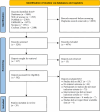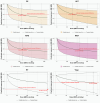Optimal exercise dose on Body Mass Index (BMI) in children and adolescents with overweight and obesity: a systematic review and bayesian model-based network meta-analysis
- PMID: 39827114
- PMCID: PMC11742208
- DOI: 10.1186/s12889-025-21405-3
Optimal exercise dose on Body Mass Index (BMI) in children and adolescents with overweight and obesity: a systematic review and bayesian model-based network meta-analysis
Abstract
Background: Exercise is widely used for obesity management, but the optimal doses of exercise for improving body mass index (BMI) in children and adolescents with overweight and obesity remain unclear. This study aimed to evaluate the dose‒response effects of various exercises on BMI in children and adolescents with overweight and obesity.
Methods: A systematic search was conducted in Web of Science (Core Collection), PubMed/MEDLINE, Embase, Scopus, and the Cochrane Library for randomized controlled trials on relevant studies, covering literature up to July 2024. Three independent reviewers assessed bias via the Cochrane risk of bias tool. The quality of evidence was assessed using Confidence in Network Meta-Analysis framework. A dose‒response network meta-analysis was used to evaluate the impact of various exercise interventions and explore dose‒response relationships. All outcomes were analyzed with the mean difference (MD) and 95% credible intervals (CrIs) calculated for combined statistics.
Results: The study included 39 publications with 1,814 participants, 47.3% female and a median age of 14 years. The intervention involved six exercise modalities. High-intensity interval training demonstrated a significant reduction in BMI (MD = -1.33, 95% CrIs - 2.01 to -0.66), followed by combined exercise (MD = -1.25, 95% CrIs - 1.93 to -0.61), moderate-intensity continuous training (MD = -1.09, 95% CrIs - 1.73 to -0.45), and mixed aerobic exercise (MD = -1.05, 95% CrIs - 1.67 to -0.42). There was an 'L'-shaped nonlinear dose-response relationship between total exercise dose and BMI, with 200 METs-min/day identified as the minimum exercise dose required to achieve a clinically meaningful reduction in BMI.
Conclusion: Low-quality evidence indicates that HIIT, CE, MAE, and MICT improve BMI in children and adolescents with overweight and obesity, with clarified exercise doses for clinical benefit. These findings are relevant for exercise prescription and public health policy.
Trial registration: CRD42024566450.
Keywords: Bayesian network meta-analysis; Children and adolescents; Dose response; Exercise; Obesity.
© 2025. The Author(s).
Conflict of interest statement
Declarations. Ethics approval and consent to participate: Not applicable. Consent for publication: Not applicable. Competing interests: The authors declare no competing interests.
Figures





Similar articles
-
Folic acid supplementation and malaria susceptibility and severity among people taking antifolate antimalarial drugs in endemic areas.Cochrane Database Syst Rev. 2022 Feb 1;2(2022):CD014217. doi: 10.1002/14651858.CD014217. Cochrane Database Syst Rev. 2022. PMID: 36321557 Free PMC article.
-
Exercise Dose and Weight Loss in Adolescents with Overweight-Obesity: A Meta-Regression.Sports Med. 2019 Jan;49(1):83-94. doi: 10.1007/s40279-018-01040-2. Sports Med. 2019. PMID: 30560421
-
Effect of high-intensity interval training on cardiorespiratory in children and adolescents with overweight or obesity: a meta-analysis of randomized controlled trials.Front Public Health. 2024 Jan 26;12:1269508. doi: 10.3389/fpubh.2024.1269508. eCollection 2024. Front Public Health. 2024. PMID: 38344230 Free PMC article.
-
Face-to-face physical activity incorporated into dietary intervention for overweight/obesity in children and adolescents: a Bayesian network meta-analysis.BMC Med. 2022 Sep 2;20(1):325. doi: 10.1186/s12916-022-02462-6. BMC Med. 2022. PMID: 36056358 Free PMC article.
-
Impact of Game-Based Health Promotion Programs on Body Mass Index in Overweight/Obese Children and Adolescents: A Systematic Review and Meta-Analysis of Randomized Controlled Trials.Child Obes. 2018 Feb/Mar;14(2):67-80. doi: 10.1089/chi.2017.0250. Epub 2017 Nov 29. Child Obes. 2018. PMID: 29185787
Cited by
-
Lifestyle, Age, and Heart Disease Evidence from European Datasets.Healthcare (Basel). 2025 May 12;13(10):1123. doi: 10.3390/healthcare13101123. Healthcare (Basel). 2025. PMID: 40427960 Free PMC article.
-
Impact of exercise on cardiovascular disease risk in overweight or obese children and adolescents: a systematic review and meta-analysis.BMC Sports Sci Med Rehabil. 2025 Aug 5;17(1):225. doi: 10.1186/s13102-025-01228-w. BMC Sports Sci Med Rehabil. 2025. PMID: 40765054 Free PMC article.
-
Sex-Specific Physical Activity and Weight Status in German Schoolchildren: Interim Results from the Hand on Heart Study.Children (Basel). 2025 Mar 26;12(4):412. doi: 10.3390/children12040412. Children (Basel). 2025. PMID: 40310062 Free PMC article.
-
The effect of exercise training videos on self-esteem of 7-10-year-old obese girls: A randomized controlled trial.BMC Public Health. 2025 May 7;25(1):1684. doi: 10.1186/s12889-025-22832-y. BMC Public Health. 2025. PMID: 40336009 Free PMC article. Clinical Trial.
References
-
- Abarca-Gómez L, Abdeen ZA, Hamid ZA, Abu-Rmeileh NM, Acosta-Cazares B, Acuin C, et al. Worldwide trends in body-mass index, underweight, overweight, and obesity from 1975 to 2016: a pooled analysis of 2416 population-based measurement studies in 128·9 million children, adolescents, and adults. Lancet. 2017;390:2627–42. - PMC - PubMed
-
- World Health Organization, Obesity. and overweight. 2024.https://www.who.int/news-room/fact-sheets/detail/obesity-and-overweight (accessed 7 Aug2024).
-
- Lobstein CT, Brinsden H. Atlas of childhood obesity. London: World Obesity Federation; 2019.
-
- Hamilton D, Dee A, Perry IJ. The lifetime costs of overweight and obesity in childhood and adolescence: a systematic review. Obes Rev. 2018;19:452–63. - PubMed
-
- Sinha R, Fisch G, Teague B, Tamborlane WV, Banyas B, Allen K, et al. Prevalence of impaired glucose tolerance among children and adolescents with marked obesity. N Engl J Med. 2002;346:802–10. - PubMed
Publication types
MeSH terms
LinkOut - more resources
Full Text Sources
Medical

